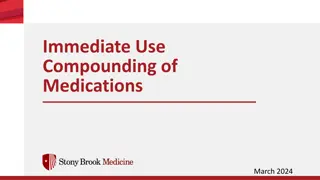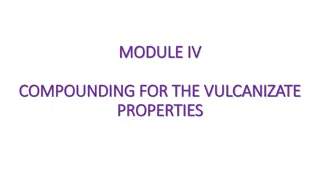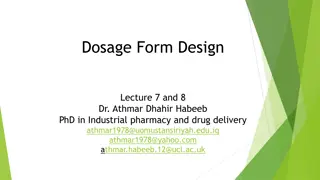Understanding Powder Dosage Forms in Pharmaceutical Compounding
Powder dosage forms offer flexibility and chemical stability but can be time-consuming to prepare, especially for unpleasant-tasting or hygroscopic drugs. Factors like particle size, density, humidity, and settling affect dosing accuracy. Methods like trituration and pulverization help in size reduction and blending of powders for effective pharmaceutical compounding.
- Pharmaceutical Compounding
- Powder Dosage Forms
- Trituration
- Size Reduction
- Pharmaceutical Preparations
Download Presentation

Please find below an Image/Link to download the presentation.
The content on the website is provided AS IS for your information and personal use only. It may not be sold, licensed, or shared on other websites without obtaining consent from the author. Download presentation by click this link. If you encounter any issues during the download, it is possible that the publisher has removed the file from their server.
E N D
Presentation Transcript
POWDERS M. Venkata Swamy Associte Professor, MLRIP Department of Pharmaceutics
POWDERS AS A DOSAGE FORM Powders are prepared either as dusting powders which are applied locally, dentifrices, products for reconstitution, insufflations and aerosols. Department of Pharmaceutics
Advantages of Powders as a dosage form: Flexibility in compounding and good chemical stability. Disadvantages of powders as a dosage form: Time-consuming to prepare Not suited well for dispensing the unpleasant-tasting or hygroscopic drugs. Inaccuracy of dose for bulk powders. Department of Pharmaceutics
The dose is influenced by many factors, including size of measuring spoon, density of powder, humidity, degree of settling and fluffiness due to agitation. Department of Pharmaceutics
Preparation of powder dosage forms SIZE REDUCTION Reduction of particle size of all ingredients with the same range to prevent separation of large and small particles. Department of Pharmaceutics
Trituration This term refers to the process of reducing substances to fine particles by rubbing them in a mortar with a pestle. This results in blending powders and breaking up soft aggregates of powders. materials are to be When granular or crystalline incorporated into a powdered product, these materials are Department of Pharmaceutics triturated individually and then blended together in the
Pulverization by Intervention This is the process of reducing the state of solids with the additional material as volatile solvents which can be removed easily after the pulverization has been completed and the powdered material is obtained. This technique is applied to substances which are gummy and tend to reagglomerate or which resist grinding. Example: Camphor trituration because of its gummy properties, can be which cannot be pulverized easily by Department of Pharmaceutics
reduced to a fine powder by the addition of a small amount of alcohol or other volatile solvent. Iodine crystals can be triturated with the aid of a small quantity of ether. Department of Pharmaceutics
Levigation In this process a paste is first formed by the addition of a suitable non-solvent to the solid material. Particle-size reduction then is accomplished by robbing the paste in a mortar with a pestle. Levigation technique is used to incorporate solids into ointments and suspensions. Department of Pharmaceutics
BLENDING (MIXING) Blending is used when two or more substances are to be combined to form a uniform powder mixture. Depending upon the nature of the ingredients and the amount of powder to be prepared mixing may be by spatulation, trituration, sifting, tumbling or by mechanical mixers. Department of Pharmaceutics
Spatulation Department of Pharmaceutics
Trituration Department of Pharmaceutics
For chemicals that may stain the porcelain or Wedgewood surface, a glass mortar may be preferred. Department of Pharmaceutics
When By this method, the potent drug placed upon an equal volume the diluent in a mortar and the mixture is mixed by trituration. Then a second portion of diluent equal in volume to the powder mixture in the mortar is added, and the trituration is repeated. This process is continued by adding equal volumes of diluent to that powder present in the mortar and repeating the mixing until all of the diluent is incorporated. Department of Pharmaceutics
Sifting Powders may also be mixed by passing them through sifters. This process results in a light fluffy product. This process is not acceptable for the incorporation of Department of Pharmaceutics
potent drugs into a diluent base. Department of Pharmaceutics
Tumbling The powder enclosed in a large container which rotates generally by a motorized process. Such blenders are widely employed in industry to blend large amounts of powder. Department of Pharmaceutics
PROBLEMS IN POWDER MANUFACTURE The incorporation of volatile substances, eutectic mixtures, liquids and hygroscopic substances into powders presents problems that require special treatments. Department of Pharmaceutics
Volatile Substances The loss of camphor, menthol and essential oils by volatilization when incorporated into powders may be prevented or retarded by use of heat-sealed plastic bags or by double wrapping with a waxed or glassine paper inside a bond paper. Department of Pharmaceutics
Eutectic Mixtures Department of Pharmaceutics
prevented eutexia with aspirin, phenyl salicylate. This technique offers the advantage of extended product stability. Department of Pharmaceutics
Magnesium carbonate or light magnesium oxide are used commonly as effective diluents for this purpose. An amount of diluent equal to the eutectic compounds is sufficient to prevent liquefaction for about 2 weeks. first with a Each eutectic compound should be mixed portion of the diluent and gently blended together, preferably with a spatula on a sheet of paper. Department of Pharmaceutics
Liquids Liquids may be incorporated into divided powders. Magnesium carbonate, starch or lactose may be added to increase the absorbability of the powders if necessary. When the liquid is a solvent for a nonvolatile heat-stable compound, it may be evaporated gently on a water bath. Lactose may be added during the evaporation to increase the rate of solvent loss by increasing the surface area. Some extracts and tinctures may be treated in this manner, Department of Pharmaceutics
although the use of an equivalent amount of a powdered extract is a more desirable technique. Department of Pharmaceutics
Hygroscopic Substances Substances that become moist because of affinity for moisture in the air may be prepared as divided powders by adding inert diluents. Double-wrapping is desirable for further protection. Extremely Hygroscopic compounds cannot be prepared as powders. Department of Pharmaceutics
Use and Packaging of Powders Depending upon their use, powders are packaged and dispensed in two main ways: Bulk powders. Divided powders. Department of Pharmaceutics
BULK POWDERS Example of the bulk powders are: Oral powders: as antacid and laxative powders, it can be taken by mixing an amount of powder in a portion of water or other beverage and swallowing as solution or suspension. Douche powders: generally dissolved in warm water and used as antiseptics or cleansing agents for a body cavity as for vaginal use. Department of Pharmaceutics
Douche powders are Dispensed in wide-mouth glass jars serves to protect against air and moisture or loss of volatile materials Department of Pharmaceutics
Dusting Powders: Medicated medicated for external application for or non- various parts of the body as lubricants, protectives, absorbents, antiseptics, astringents and antiperspirants agents. Dusting Powders are usually dispensed in sifter containers for convenient application to the skin. Foot powders and talc powders are currently available as aerosols. Dentifrices: Dental cleansing powders, used in dental Department of Pharmaceutics
hygiene. Denture powders, some used as dentifrices and others as adhesives to hold the dentures in place. Department of Pharmaceutics
All powders should be stored in tightly closed containers for Protection against humidity, air oxidation and loss of volatile ingredients. Dispensing powdered drugs in bulk amounts limited to non-potent substances. Powders containing potent substances or those that Department of Pharmaceutics Supplied to the patient in divided amounts.
should be administered in controlled dosage are Department of Pharmaceutics
DIVIDED POWDERS After the powder has been mixed, it may be divided into individual doses. Each divided portion of powder may be placed on a small piece of paper or metal foil which is then folded or in small heat-sealed plastic bags so as to enclose the medication. Hygroscopic and volatile drugs can be protected by using a waxed paper; Department of Pharmaceutics























